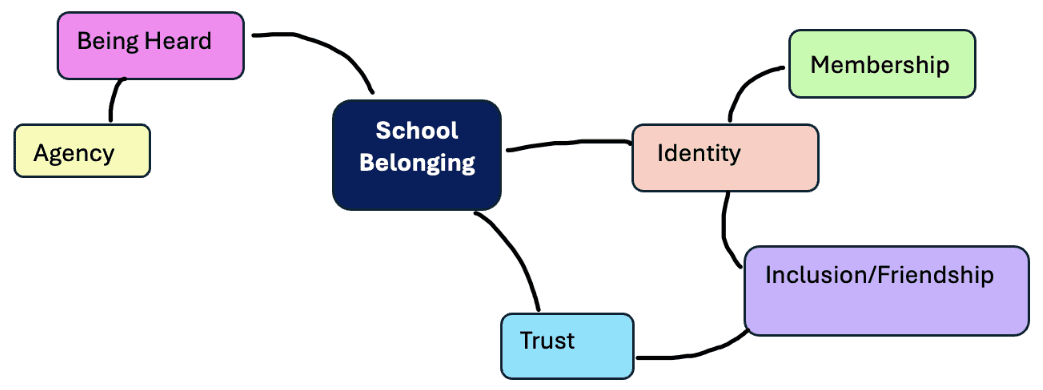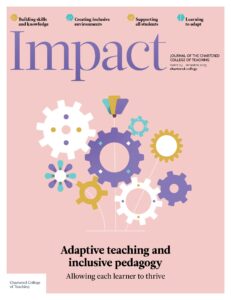Belonging in school: Creating an inclusive environment

LIZZIE NURSE, ASSISTANT HEAD SENDCO, SHERBORNE GIRLS, UK
This perspective piece considers the importance of school belonging to all students, but especially to students with SEND (special educational needs and disabilities), who tend to have a much lower sense of belonging than their peers. In the current school climate, where absenteeism and mental health issues are two of the biggest obstacles to success for young people, exploring how to create a curriculum and environment that helps to counter these may be the most valuable activity that schools can undertake. This article explores research on the varied impact of staff and peer relationships, extra-curricular activities, inclusionAn approach where a school aims to ensure that all children are educated together, with support for those who require it to access the full curriculum and contribute to and participate in all aspects of school life and student agency as potential factors in creating a sense of school belonging, as well as reflections on my own setting, a single-sex boarding school, and whether the research matches the student experience there.
Over 30 years ago, Goodenow and Grady were discussing the importance of school belonging, defined by them as ‘the extent to which students feel personally accepted, respected, included and supported by others in the school social environment’ (1993, p. 80), and this has been widely studied since as an important factor in academic attainment, motivation and wellbeing. Students with SEND often have lower feelings of school belonging than students without SEND, so focusing on getting the relationships and environment right for them feels like a priority in the current educational climate. Dimitrellou and Hurry (2019) found that students with behavioural difficulties had lower school belonging than those with learning difficulties, but that both groups of students with SEND associated positive relationships with teachers and an inclusive school ethos with higher feelings of belonging.
To assess school belonging in more depth, Allen et al. (2018) conducted a systemic meta-analysisA quantitative study design used to systematically assess the results of multiple studies in order to draw conclusions about that body of research, splitting their findings into individual, micro and meso factors. They found that teacher support (micro) had the strongest effect, followed by personal characteristics (individual) and then parent support (micro) and peer support (micro), with extra-curricular (meso) not significantly impacting school belonging. This surprised me because in my setting – a full-boarding, all-girls’ secondary school – the students’ wellbeing seems more closely reliant on their peer relationships.
Research conducted
An initial Likert-scale survey was sent to the entire student body of 480, based on previous peer-reviewed connectedness scales such as Karcher and Lee’s (2002) Hemingway Measure of Adolescent Connectedness (HMAC) and the School Connectedness Scale (SCS) (Lohmeier and Lee, 2011). A total of 134 returned responses allowed the analysis of broader trends and provided an overall school belonging score to assist with selecting a representative sample of eight students from whom to collect qualitative data. These included girls with a range of school belonging scores, chosen from all key stages, and included both students with and without SEND. Semi-structured interviews were then conducted, with the aim of exploring which factors were most significant in creating higher feelings of school belonging. These were thematically analysed, leading to the themes shown in Figure 1 emerging.

Figure 1: Themes emerging from survey responses
Being heard and being seen
A large part of the school belonging feeling for many of the girls was a sense that they were seen as an individual, which aligns with Goodenow and Grady’s (1993) definition. This was something that they mainly linked to staff. Having staff speak to them as young adults, try to see things from their perspective and develop meaningful relationships with them were all seen as important factors in this area. One student even mentioned how much just a smile in the corridor can mean. Pupil voice opportunities, developing class discussions and allowing group work in lessons were intrinsically linked to positive feelings of school belonging. Students with SEND benefit from working in flexible grouping, both homogenous and heterogeneous, based on specific learning outcomes (McLeskey et al., 2017); streaming or always allocating groups based on prior attainment can be detrimental to students’ learning, attitude and engagement (EEF, 2020).
Agency
Another area of importance to the students was the concept of agency and choice over their activities, time and life. As this was the area with which school children across the UK were least satisfied (The Children’s Society, 2022), it is perhaps unsurprising that it also featured in my school. As a boarding school, we also schedule a fair amount of students’ weekends, so trying to offer some time to decompress and allowing as much choice as practicable over the activities on offer were important. Many students spoke enthusiastically about the range of activities on offer, which added significantly to their school belonging scores. However, if other students were perceived to be enjoying the activity, those who weren’t felt like outsiders (Anderman, 2002), and some of the more popular activities with the students without SEND were the ones least enjoyed by the students with SEND. Ensuring that the activities chosen reflect the interests of the whole cohort could be a key aspect of boosting the school belonging feelings of students with SEND, so ensuring that regular pupil voice opportunities around this area take place should be part of good practice.
The other key area mentioned was agency over personal space and living arrangements – especially for neurodiverse girls, for whom, having to mask all day without respite can be particularly challenging in this setting. Providing spaces in which to decompress and giving as much choice over sleeping arrangements as possible are vital for students who struggle with the demands of communal living in this way. Sensory rooms and designated quiet areas could be valuable assets in all schools.
Trust
Another theme that emerged was the notion of trust, in both staff and peers, in making the girls feel secure at school. The support offered by the school was praised and was often seen as the strongest area, although many of the girls admitted that they have not used the systems that have been put in place. There were concerns that accessing social, emotional and mental health (SEMH) support in school would get back to their parents, who they worried would not be supportive. Providing clear guidelines around what information needs to be shared and at what stage may provide some clarity and reassurance for students.
Trust in peers was also a significant factor, especially in a full-boarding environment, with one girl mentioning the fact that ‘they’re the last people you see at night and first people you see in the morning’, suggesting that for students with low school belonging, the evenings and mornings are perhaps the hardest time, when other students would have the privacy of home to put on their armour and face the day. Being aware of this and helping students with strategies to navigate the non-structured time may be invaluable. The transition from home to school can often be a difficult point for SEND students in other settings, so developing systems such as soft starts, early check-ins with a trusted member of staff and the ability to avoid any congested or noisy areas can help these students to begin their day calmly and positively.
Identity
Unsurprisingly, feeling able to be yourself is the clearest indicator of school belonging from these interviews, with those who do not fit the norm feeling that they have to adapt rather than be accepted. This is a particularly important area for students with SEND and may be one of the most significant reasons behind their lower school belonging scores. Ensuring that the school’s ethos of inclusivity is truly felt by all students is paramount. Making classrooms places where neurodiverse students feel ready to learn, by minimising distractions from displays, allowing them agency over their place in the seating plan, encouraging an inclusive atmosphere and following any recommendations from one-page profiles, means that students with SEND feel able to be themselves while learning, which improves both engagement and wellbeing.
Inclusion
The final theme related to being included and focused entirely on peer relationships. The importance of friends impacted lessons, extra-curricular activities and house time. Every aspect of these interviews pivoted around peer relationships, contradicting much of the established research, which places teacher relationships above peer ones. This matches my original assumptions about the importance of peer interactions when the time spent with them increases; in a boarding school, having strong friendships is paramount to happiness. Teachers can help to develop these stronger peer links by providing a variety of lesson styles to avoid prescribing the ‘ideal’ learner and potentially creating counterproductive views about themselves from students who don’t ‘fit’ (Darling-Hammond and Cook-Harvey, 2018). Student with SEND particularly benefit from lessons where there are opportunities to learn and use social and emotional skills, followed by specific positive feedback (McLeskey et al., 2017).
Conclusions
The initial survey data did reinforce the fact that the students with SEND generally had lower school belonging scores than students without SEND. On average, they scored lower across all areas of questions – staff relationships, peer relationships and school environment. One of the clearest trends to come out of this data for all students was the importance of peer relationships, which have an impact on students feeling comfortable to ask questions in lessons, taking part in extra-curricular activities, having a friendship group on whom to lean when things are tough and feeling like they can relax and be vulnerable around the people who share their home. The sheer amount of time that the girls spend with each other in a boarding setting means that this must be the key area to get right to ensure that they feel they belong at the school. The importance of staff relationships was higher when the girls considered the house staff than the teaching staff, which again does not seem surprising. From their teachers, the girls needed to feel warmth, a genuine interest in them as individuals and authentic praise for things that mattered to them. Making the time to build effective relationships with every child, which could start with something as small as a smile in the corridor, can lead to lower anxiety and higher feelings of school belonging.
The two most significant areas in which the school could make changes to improve school belonging are inclusion and agency. Focusing on equality, diversityThe recognition of individual differences in terms of race, ethnicity, gender, sexual orientation, socio-economic status, physical ability, religious beliefs and other differences and inclusion (EDI) and creating a truly inclusive atmosphere, where all the girls feel that they can be themselves without judgement, needs to be the priority. Celebrating all forms of difference, including SEND, may help to create a more inclusive atmosphere for these students. Secondly, offering as much choice as is feasible over the way in which the students spend their free time, how they access the curriculum and their living arrangements could be a successful strategy to help some of the students with SEND in particular feel more relaxed.
- Allen K, Kern ML, Vella-Brodrick D et al. (2018) What schools need to know about fostering school belonging: A meta-analysis. Educational Psychology Review 30: 1–34.
- Anderman ΕM (2002) School effects on psychological outcomes during adolescence. Journal of Educational Psychology 94: 795–809.
- Darling-Hammond L and Cook-Harvey CM (2018) Educating the whole child: Improving school climate to support student success. Learning Policy Institute. Available at: https://learningpolicyinstitute.org/sites/default/files/product-files/Educating_Whole_Child_REPORT.pdf (accessed 7 March 2025).
- Dimitrellou E and Hurry J (2019) School belonging among young adolescents with SEMH and MLD: The link with their social relations and school inclusivity. European Journal of Special Needs Education 34(3): 312–326.
- Education Endowment Foundation (EEF) (2020) Special educational needs in mainstream schools: Guidance report. Available at: https://d2tic4wvo1iusb.cloudfront.net/production/eef-guidance-reports/send/EEF_Special_Educational_Needs_in_Mainstream_Schools_Guidance_Report.pdf?v=1741186242 (accessed 7 March 2025).
- Goodenow C and Grady KE (1993) The relationship of school belonging and friends’ values to academic motivation among urban adolescent students. The Journal of Experimental Education 62(1): 60–71.
- Karcher MJ and Lee Y (2002) Connectedness among Taiwanese middle school students: A validation study of the Hemingway Measure of Adolescent Connectedness. Asia Pacific Education Review 3: 92–114.
- Lohmeier JH and Lee SW (2011) A school connectedness scale for use with adolescents. Educational Research and Evaluation 17(2): 85–95.
- McLeskey J, Barringer M-D, Billingsley et al. (2017) High-leverage practices in special education. Council for Exceptional Children & CEEDAR Center. Available at: https://ceedar.education.ufl.edu/wp-content/uploads/2017/07/CEC-HLP-Web.pdf (accessed 7 March 2025).
- The Children’s Society (2022) The Good Childhood Report 2022. Available at: www.childrenssociety.org.uk/information/professionals/resources/good-childhood-report-2022 (accessed 1 August 2024).











The importance of a smile in the corridor, a meaningful (to them) piece of praise and friendship. Salutary reminders of the humanity needed to create a community where belonging is possible. We’re human first.
Brilliant and insightful thoughts.